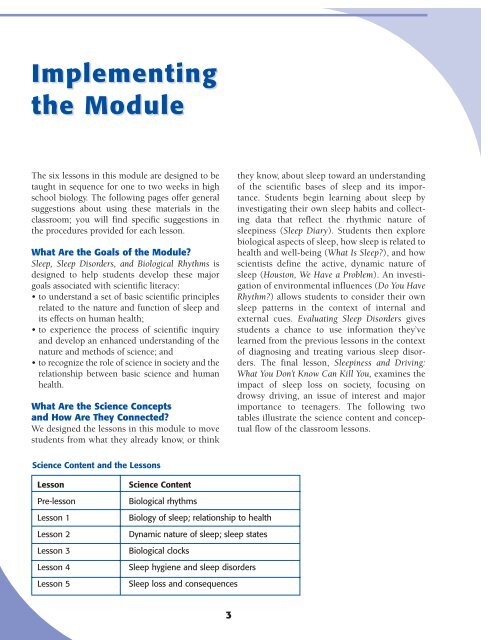Biological - NIH Office of Science Education - National Institutes of ...
Biological - NIH Office of Science Education - National Institutes of ...
Biological - NIH Office of Science Education - National Institutes of ...
Create successful ePaper yourself
Turn your PDF publications into a flip-book with our unique Google optimized e-Paper software.
Implementing<br />
the Module<br />
The six lessons in this module are designed to be<br />
taught in sequence for one to two weeks in high<br />
school biology. The following pages <strong>of</strong>fer general<br />
suggestions about using these materials in the<br />
classroom; you will find specific suggestions in<br />
the procedures provided for each lesson.<br />
What Are the Goals <strong>of</strong> the Module?<br />
Sleep, Sleep Disorders, and <strong>Biological</strong> Rhythms is<br />
designed to help students develop these major<br />
goals associated with scientific literacy:<br />
• to understand a set <strong>of</strong> basic scientific principles<br />
related to the nature and function <strong>of</strong> sleep and<br />
its effects on human health;<br />
• to experience the process <strong>of</strong> scientific inquiry<br />
and develop an enhanced understanding <strong>of</strong> the<br />
nature and methods <strong>of</strong> science; and<br />
• to recognize the role <strong>of</strong> science in society and the<br />
relationship between basic science and human<br />
health.<br />
What Are the <strong>Science</strong> Concepts<br />
and How Are They Connected?<br />
We designed the lessons in this module to move<br />
students from what they already know, or think<br />
they know, about sleep toward an understanding<br />
<strong>of</strong> the scientific bases <strong>of</strong> sleep and its importance.<br />
Students begin learning about sleep by<br />
investigating their own sleep habits and collecting<br />
data that reflect the rhythmic nature <strong>of</strong><br />
sleepiness (Sleep Diary). Students then explore<br />
biological aspects <strong>of</strong> sleep, how sleep is related to<br />
health and well-being (What Is Sleep?), and how<br />
scientists define the active, dynamic nature <strong>of</strong><br />
sleep (Houston, We Have a Problem). An investigation<br />
<strong>of</strong> environmental influences (Do You Have<br />
Rhythm?) allows students to consider their own<br />
sleep patterns in the context <strong>of</strong> internal and<br />
external cues. Evaluating Sleep Disorders gives<br />
students a chance to use information they’ve<br />
learned from the previous lessons in the context<br />
<strong>of</strong> diagnosing and treating various sleep disorders.<br />
The final lesson, Sleepiness and Driving:<br />
What You Don’t Know Can Kill You, examines the<br />
impact <strong>of</strong> sleep loss on society, focusing on<br />
drowsy driving, an issue <strong>of</strong> interest and major<br />
importance to teenagers. The following two<br />
tables illustrate the science content and conceptual<br />
flow <strong>of</strong> the classroom lessons.<br />
<strong>Science</strong> Content and the Lessons<br />
Lesson<br />
Pre-lesson<br />
Lesson 1<br />
Lesson 2<br />
Lesson 3<br />
Lesson 4<br />
Lesson 5<br />
<strong>Science</strong> Content<br />
<strong>Biological</strong> rhythms<br />
Biology <strong>of</strong> sleep; relationship to health<br />
Dynamic nature <strong>of</strong> sleep; sleep states<br />
<strong>Biological</strong> clocks<br />
Sleep hygiene and sleep disorders<br />
Sleep loss and consequences<br />
3

















